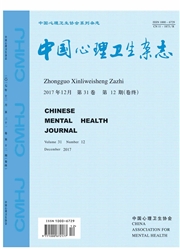

 中文摘要:
中文摘要:
目的:探讨汉语发育性阅读障碍儿童存在的语言能力缺陷。方法:采用学习困难儿童筛查量表(PRS)、韦氏智力测验(WISC-R)和儿童读写能力家长问卷,从广州市某小学8-12岁儿童中,筛查出13位发育性阅读障碍的儿童,按年龄、性别、年级1∶1匹配正常对照组,应用语音技能、快速命名和词形加工测验等对两组儿童的语言能力进行测试。结果:阅读障碍组在语音技能测验中的辨声母、辨韵母、语音合成三项测验的正确数均低于正常儿童(5.8±2.1/8.8±1.2,5.3±2.7/7.0±2.6,3.7±2.6/5.8±2.7,t=-4.696、-2.690、-0.555,P〈0.05);快速命名测验的两项分测验-颜色和数字快速命名测验时间均长于正常儿童(37.9±8.6/28.0±4.5,19.5±2.7/15.6±3.7,t=4.348、3.048,P〈0.05);而词形加工测验中,汉字命名测验成绩明显低于正常儿童(31.8±4.6/35.7±2.8,P〈0.05),辨真假字两组的成绩无显著差异(P〉0.05)。结论:汉语阅读障碍儿童存在语音意识缺陷和快速命名缺陷等语言能力缺陷。
 英文摘要:
英文摘要:
Objective: To explore the language deficiency of Chinese children withh devclopmcntal dyslexia. Methods: Thirteen children with developmental dyslexia were screened by PRS, WISC-R and patriarchal questionnaires about children's reading and writing ability from children aged 8 -12 in a primary school in Gnangzhou. Thirteen non-dyslexic children with the same age, sex and grade were selected as the control group. Three trsts (phonological skill, naming speed and word form processing tests) were designed to investigate the lingnistie capaeity of Chinese dyslexic, children. Results: In phonological tests, children with developmental dyslexin had significantly lower scores in initial differentiating, final differentiating and sound blending subtests (5.8 ± 2. 1/8.8 ± 2, 5.3 ± 2. 7/7. 0± 2. 6, 3.7 ± 2. 6/5.8± 2.7, t = - 4. 696, - 2. 690, - 0. 555, P 〈 0. 05 ) . Thcv also bad significantly lower scores in color and number naming speed subtests ( 37.9 ± 8. 6/28. 0± 4. 5, 19. 5 ± 2. 7/15.6 ± 3.7, t = 4. 348, 3. 048, P 〈 0. 05 ) , which of naming speed test. The difference between the two groups in the character decision test was not significant ( P 〉 0. 05 ) ; while in the naming Chinese character test,the difference was significant (31.8 ±4. 6/35.7± 2. 8, P 〈 0. 05 ) . Conclusions: Chinese dyslexic children have deficiency in the liagnistie capacity of phonological awareness and naming speed ability.
 同期刊论文项目
同期刊论文项目
 同项目期刊论文
同项目期刊论文
 期刊信息
期刊信息
